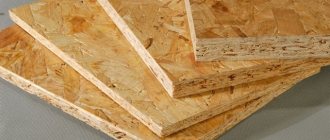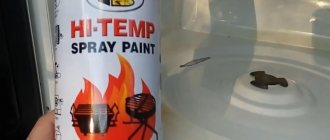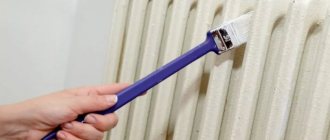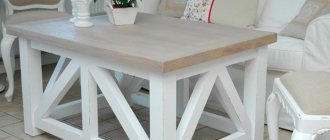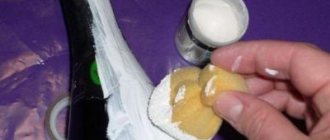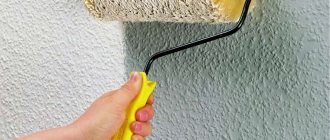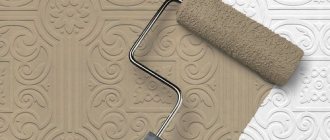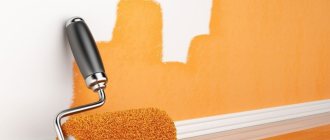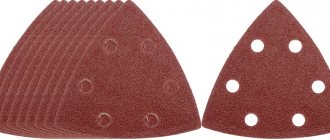Polyvinyl chloride or PVC is a popular material from which many parts, structures and products are made. Over time, the surface of this material wears out, abrasions appear on it, the paint fades, in which case the question arises, how and with what to paint PVC? Sometimes it is necessary to paint metal-plastic windows and doors in a different color so that they fit better into the interior design, or there is a need to protect the surface from destruction and fading. To process smooth PVC, not just any paint will do, especially if you need to paint plastic car parts, a soft inflatable PVC boat, plastic pipes or any other products.
Paint requirements
The main requirement for PVC paint is a high adhesion rate (adhesion to the surface). Polyvinyl chloride differs from wood, brick and concrete in that it has a very smooth and slippery surface, the structure is quite dense and hard, as a result of which plastic cannot be painted with any type of composition. The paint must have the following characteristics and properties:
- resistance to moisture, water;
- high strength;
- resistance to mechanical damage;
- preservation of the shade throughout the entire service life;
- resistance to ultraviolet rays;
- the composition must be environmentally friendly, safe for humans, without toxic, poisonous components that could be released into the air during heating;
- resistance to temperature changes;
- long service life;
- large selection of shades;
- the ability to give the object being painted some kind of texture.
In addition to all the above properties, it is important to choose a composition that you can easily paint with your own hands at home.
How to choose the right paint
The paint for covering the boat is chosen based on the characteristics of the material from which the boat is made. Some paints are strictly contraindicated when painting aluminum boats, but work well on the surface of plywood boats.
For aluminum boat
Aluminum swimming equipment is strong and durable and requires special care. Repairs are done periodically, updating the paint, strengthening the bottom and internal parts.
Aluminum boats are painted using any of the recommended methods:
- Powder method. It involves applying powder paints using special devices. Powder coating is possible only after special treatment with chemicals. It is applied after priming and stripping. A spray gun designed for applying powder compositions operates from an electrical network only if the necessary pressure arises inside the device to transform the powder into paint.
- Anodizing. This method involves creating a special oxide film on the surface of aluminum using additional devices. It is impossible to cover a boat using this method at home.
See also
Technical characteristics and composition of VL-02 primer, rules of application
When choosing anodizing, it is necessary to take into account that the surface will be painted gray-green. If you powder coat the boat, you can choose your own shades and experiment with colors.
For PVC and plastic
Boats made of PVC material are quite common, they are convenient to store, assemble and disassemble. Plastic boats are usually used for domestic needs. To paint PVC or plastic surfaces, purchase paints and varnishes that are resistant to mechanical or chemical attack.
Some fishermen prefer to cover PVC with a special film without using paints and varnishes. This technique is suitable for those who are ready to repair their vehicle every season.
Fiberglass hulls, which are additionally impregnated with epoxy resin, are coated with paints with high water-repellent properties. In addition, the bottoms of boats are treated with a compound called antifouling, which prevents the growth of algae.
For wooden boats
To paint a wooden boat, you need to choose a material that has high water-repellent properties and creates a durable, damage-resistant coating.
Before painting wood, it is treated with special liquids that ensure the preservation of the material. Wood impregnation is an antiseptic that promotes adhesion and protects the surface. It is best to choose a type of impregnation that is compatible with any type of paint finish. The impregnation is applied with a wide brush, then left until completely dry.
Wooden boats are most often painted with lead white with the addition of various colors. This allows you to get different shades. The final stage is varnishing. Varnish increases the strength of the coating and prevents wooden elements from cracking.
For plywood boats
Boats or boats constructed from plywood must be coated with epoxy paints. Working with plywood boats includes several stages:
- Impregnation of plywood from moisture. For this purpose, special compounds are used. If the plywood is not well treated against moisture, then after several uses the body material will swell.
- Grinding. After drying, the body is cleaned with sandpaper.
- Padding. All small cracks and defects are covered with a layer of primer mixture compatible with the selected paint. Drying oil or red lead primer are often used as a primer layer.
Expert opinion
Zakharova Irina Yurievna
Cleaning professional with 15 years of experience. Our best expert.
Ask a Question
The treatment results in the formation of a durable elastic coating on the surface after painting, which protects the boat from moisture.
Attention! Plywood cases are covered with four layers of enamel.
Polyurethane-acrylic paints
These dyes fully comply with all the necessary characteristics, these compositions are made on a water basis, they are often used to paint PVC, for example, plastic windows or other structures. Polyurethane-acrylic mixtures create a uniform coating that is resistant to scratches and other defects. The dye dries quickly enough on the PVC surface; if desired, you can tint the composition yourself. Thanks to these dyes, you can easily and quickly paint PVC, and it is possible to create any textured effects if you add special ingredients to the base paint.
Polyurethane-acrylic paints are made in a huge range of colors; the catalog contains more than two thousand different shades. In addition to traditional colors, manufacturers offer:
- pearlescent paints;
- with sparkles;
- metallic
Using such extraordinary dyes, you can paint any PVC surface in a unique and original way.
Coating protection
Despite the fact that acrylic paints adhere well to the surface of PVC products, they can be further protected using a glossy water-based plastic varnish. In addition to the protective function, it also performs a decorative function, giving the product shine.
This material can be used to treat painted plastic window sills and windows in kitchens, where they are exposed to aggressive factors.
The varnish is applied with a brush and does not require any special skills. Therefore, these works are easy to do with your own hands.
Fire retardant paints, which are often used on metal surfaces, are also suitable for protecting kitchen window sills and pipes running close to open fires.
Preparation before painting
Before painting any PVC product, for example, a window sill, plastic windows, or anything else, it is important to properly prepare the surface. Preparation includes:
- dismantling all structural elements that will interfere with painting. For example, you need to remove the tide, tulle, curtain, blinds, mosquito net and other items from the window;
- any contaminants are removed from the surface, for example, dust, cobwebs, debris, dirt, etc.;
- grease stains are removed using a solvent;
- Construction (painting) tape protects all fittings, rubber seals and other elements so that paint does not get on them. When the painting solution has dried, the masking tape must be removed immediately, otherwise it will be much more difficult to remove it after a few days;
- It is advisable to cover the glass with cellophane film, or you will have to remove the paint from the glass surface with a rag immediately before it dries.
To carry out high-quality, effective cleaning, degrease the surface and remove static stress from it, you can purchase a special activator cleaner in the store, which is designed specifically for PVC. This cleaner is applied to a cloth or rag, and the entire surface is thoroughly wiped with it. After wiping, the composition should completely evaporate, this usually takes about 10 minutes, after which you can paint the PVC with the chosen paint.
If there are scratches, any defects, chips or roughness on the surface, they are covered with a special putty compound, after which the structure is sanded with fine-grained sandpaper. After sanding, it is recommended to treat the PVC with a primer mixture. If you have experience and skills in the field of repair and finishing work, then you can do the filling and sanding yourself, but if you lack experience, it is advisable to seek the services of specialists.
Preparing for coloring
The preparatory stage is very important, since the glossy surface of PVC a priori does not contribute to good adhesion with the new coating, especially if it is dirty. And plastic is highly electrified, which is why it attracts dust particles and specks like a magnet. The cleaner the surface is before applying paint, the longer the new coating will last. Therefore, the surface is thoroughly cleaned. Traces of dust, grease and dirt are not allowed on it. First, all remnants of silicone sealants, foam, packaging film, etc. are cleaned off. After washing the profiles with detergents and cleaning agents, rinse them thoroughly with clean water. Professionals clean surfaces with compressed air, “blowing off” the smallest particles in this way. The glass perimeter is covered with masking tape or tape. The handles are removed. For degreasing, use a special solution or alcohol. This treatment also removes static electricity. After the degreasing solution has evaporated, painting begins. Many formulations require a primer before application. This requirement is specified in the instructions for their use. The primer is applied with a paint brush in 1 layer. It can be a primer for plastic car parts. Tinting the paint and adding pigment to it is carried out no later than 1 hour before applying it. First, an inconspicuous control area is painted, checking the viscosity of the composition and hiding power. If necessary, add thinner. For acrylic composition, this is water. A mandatory step before application is filtering the paint.
The glass must be protected before painting.
Coloring rules
In order to properly paint metal-plastic windows or plastic car parts made of polyvinyl chloride, it is important to use special paint for PVC, which must be applied with a spray gun. As mentioned earlier, the best option is polyurethane-acrylic paint, which is pre-tinted to the desired shade, mixed thoroughly and poured into the spray gun container.
If, when opening a can of paint, there is a dense film on the surface of the composition, it must be removed, since this film contains solid particles that will not dissolve during mixing; they will quickly clog the spray nozzle. If the paint mixture has been frozen, it is no longer suitable for use, since in the cold the paint and varnish material loses its properties and characteristics, so it is simply thrown away.
Important! To paint PVC products with high quality, you need to choose dry, not hot, sunny weather. If the air temperature is less than +5 degrees, it is not recommended to carry out painting work.
The coloring composition is applied to the surface of a plastic window or other product in a thin, uniform layer, without gaps or drips; the layer thickness should be in the range of 80-120 microns. When using a spray gun, there is no need to first paint corners and hard-to-reach places, because the polyurethane-acrylic composition adheres well to a vertical surface and does not flow from it. After about 3 hours, the dye will already adhere firmly to the plastic, but the completely colored layer will dry only after 2-3 days. For industrial painting, after applying paint and varnish material to a PVC window, accelerated drying is used in special chambers with an air temperature of +50 degrees for 2 hours.
Painting facades
Before painting the facades, you should dismantle them, remove the handles, fittings, and cover the decorative inserts and hinges with masking tape so that nothing gets in there during painting. After this, you need to lay newspapers or film on the work surface so as not to stain the floor or kitchen table with paint. Before painting, you should also wear protective equipment: gloves, goggles and a respirator. Even if the paint is non-toxic, dust cannot be avoided during the sanding process.
Grinding
Before painting the kitchen unit, you should remove the old coating. In this case, it is necessary to treat the surface with sandpaper, first coarse-grained, and then fine. A grinding machine will greatly facilitate manual labor. You can also use nail polish remover. To remove PVC film you will need a hair dryer. With its help, you need to heat the film from the front side and carefully remove it from the facade. Please note that during the work a rather pungent odor will be released, so it is advisable to choose a non-residential premises for this procedure. After sanding, you need to remove dust from the surface with a damp sponge or rag, and then degrease it with a special solvent.
Primer
Primer for plastic or wood differs in composition, so before updating the kitchen facade, consult with a sales consultant in choosing the right product. The quality of the primer determines how well the painting will proceed. The substance must be applied in 2 thin layers. After each application, it is recommended to wait until it dries completely and then leave the product for a day.
Coloring
To properly paint kitchen facades with your own hands, you need to cover the surface with enamel in 2-3 layers using a brush with soft bristles or a roller, strictly adhering to one direction. In this case, a spray can will be very effective, as it is easy to distribute the paint evenly. When using multiple colors or shades, the borders can be protected from paint using tape. After painting, you must also wait until it dries completely. The estimated time is usually indicated on the can or spray paint can.
Finish coating
A substance called glisal is often applied to the surface of the product after painting to give it a glossy shine. The product must be diluted with water in the proportion specified in the instructions and applied to the facade. The glaze method will help create decorative patterns. Using polyethylene, a damp sponge and a hard-bristled brush, you need to move from one area to another, drawing chaotic lines and patterns. After work, you should leave the product to dry for a week. There is also an option to open the kitchen facades with regular varnish. It can be glossy or matte, but it is advisable to choose a transparent substance. Both glisal and varnish have a pungent odor, so it is necessary to ventilate the kitchen after work. When the product is dry, all that remains is to assemble it and attach the updated facades back to the set.
What could be nicer than giving new life to an old but beloved product? Anyone can feel like a designer and restorer; all it takes is desire and creative inspiration. You can paint the kitchen set with your own hands by watching the instructional video, as well as photo instructions presented on the website.
Aerosol cans
If you need to paint a small area of a window or other PVC product, you can purchase paint and varnish material in a can. This form of release is very convenient, thanks to it the paint is reliably protected from air penetration, so that a film never forms on the surface of the composition. Aerosol cans have many advantages:
- ease of transportation;
- You can easily and effortlessly paint small parts and hard-to-reach areas;
- no need to use any additional tools, such as a spray gun or brush;
- dyes in cans have an increased adhesion rate.
Aerosol paints are often used to process PVC automotive parts. In order for the paint coating to be uniform, without drips or gaps, certain skills and dexterity are needed, so first it is important to practice for a few minutes on some unnecessary product, after which, having gained a little experience, you can begin the main painting.
Floating vessel painting technology
Painting a boat yourself is a complex and expensive procedure. To achieve the creation of the most durable coating, it is necessary to properly prepare the vehicle and purchase all the necessary equipment for the job.
Removing old paint
The first stage is the removal of the old coating and the simultaneous removal of dirt, as well as adhering algae. The surface is cleaned using a special remover. It is applied over the entire staining area in a thin layer and left for 30 minutes. After this, the wash is removed with a cord brush.
See also
8 types of primers for plywood and rating of the best brands, application rules
The cleaned area is washed twice with washing powder, wiped and allowed to dry naturally.
The best option is to leave the boat upside down in the sun.
Cleaning rust
For metal cases, it is important to go through such a preparation stage as rust removal. To get rid of traces of corrosion, it is necessary to use special converters. Apply the product to the surface and wait 1 hour.
At this time, particles of the applied converter react with traces of corrosion and form a white foamy substance. It is removed with a rag or brush.
Putty and primer
Puttying is an irreplaceable step that has some features. Applying too thick a layer of primer changes the specific gravity of the hull, making the craft too heavy. For some boats, exceeding these values causes a list to occur when they are put into the water.
This can be avoided if you choose the right primer mixture and putty composition. Do not apply dense layers, and you must use sandpaper at each stage of processing.
Expert opinion
Zakharova Irina Yurievna
Cleaning professional with 15 years of experience. Our best expert.
Ask a Question
When priming and puttying, it is recommended to use special durable mixtures with a light specific gravity. The puttying composition is applied to the cleaned, prepared surface of the body using a spatula. Masters recommend purchasing 4-5 spatulas of different lengths, from 90 to 500 millimeters.
Before processing the body, all irregularities and protrusions are removed. Then they take putty. First of all, it is applied to areas where unevenness is noticeable or where panels overlap.
It is best to use putty that contrasts with the main shade of the boat. This will allow you to see how much product has been applied and control its amount.
After applying the putty over the entire surface, they begin to search for subtle defects and irregularities on the body. To do this, use wide metal rulers and glass cuttings. After identifying irregularities, treat them with a spatula of maximum width.
The final stage is the elimination of minor defects. They are covered with small spatulas. The maximum number of applied layers of putty is 5 or 6.
After creating the putty finish, all height differences between layers are processed with sandpaper No. 120, 240 or 360.
The next stage is priming. For it, special primers of gray or white color are purchased. Primer is the basis for the paint material, so it is best to use a mixture that is compatible with the paint of choice.
Reference! The result of puttying is a smooth surface that reflects the glare of the sun.
Painting the sides and bottom
To paint the boat, choose a warm, dry day with a humidity of about 60%. 10-20 minutes before painting, the entire surface of the primed body is additionally treated with fine-grained sandpaper. This technique increases adhesion between the materials to be used. The paint is applied with a spray gun, roller or brush. The maximum number of paint layers should not exceed three.
The bottom is painted first. This area bears the greatest load. The bottom wears out faster than other parts of the boat. An anti-corrosion compound with additional moisture-proof properties is used to coat the metal.
See also
Composition and scope of application of polyester paints, rules for their application
The bottom is covered to the waterline, then the sides begin to be covered. It is most convenient to apply paint to the sides using a spray bottle. It lays down evenly and does not create drips or uneven strokes.
Painting the inside of a boat
After the bottom and sides are completely dry, begin finishing the interior parts of the boat. For this purpose, acrylic paints are chosen; yacht varnish is used to create a glossy shine on wooden surfaces.
If the parts located inside the body can be pulled out, then they are painted separately, and after the paint has completely dried, they are reassembled.
Painted surface protection
The final stage of repair is to protect the painted surface from microorganisms living in the aquatic environment. Lead verdigris is used on all floating craft, except aluminum ones. This paint is formed by a complex chemical reaction between copper and acetic acid.
To protect the aluminum body, special paint is used, which contains toxic substances. The protective layer is applied after the bottoms and sides have completely dried. Most often, a spray gun or a wide brush is used for this.
Painted surface protection
Although polyurethane-acrylic and polyurethane paints and varnishes adhere well to polyvinyl chloride products, experts recommend additional protection of the painted dried layer. To do this, use special water-based varnishes, used specifically for plastic. In addition to protection, such varnishes create an attractive decorative layer, making the product shiny and beautiful.
You can varnish any painted structures, for example, metal-plastic windows or window sills, especially in places where the products are exposed to adverse factors and aggressive substances. It is advisable to varnish windows from the outside, where they are not affected by high and low temperatures, ultraviolet rays, and precipitation. You can apply the varnish with a regular brush; this does not require any skills or knowledge, so even a beginner in the field of painting can cope with this procedure.
Important! If you need to protect PVC pipes, window sills and other products located near an open fire, it is recommended to paint the surface with a special fire-retardant paint, which is also used for metal structures.
ENAMERU paint and varnish systems for painting PVC plastic
or how to paint PVC (pvc) plastic? And how to paint PVC (pvc) plastic?
Technology of painting PVC plastic - preparatory stage (preparing PVC plastic for painting)
Enamel for PVC / PVC: Polycryl Enamal LE PVC in the ENAMERU catalog.
Painting plastic is much easier than painting wood if you choose the right paint and varnish materials.
Before painting, the plastic must be checked for chips and defects on all sides, and also make sure that the client has correctly drawn up the application, in what color and on which sides the plastic will be painted. The plastic surface to be painted must be clean and dry, and there must be no glue or silicone residue on it. Immediately before painting, the following operations must be performed:
— use compressed air to clean the plastic from dust and remaining plastic chips and shavings;
— remove the protective film, if any, and protect parts of the plastic that are not to be painted with adhesive masking tape;
- use a rag soaked in a special plastic cleaner to degrease and clean the plastic from dirt and glue residues, which also removes static tension;
Important nuances
Before purchasing any amount of paint material, you first need to accurately calculate how much paint will be needed. To make a correct calculation, the first step is to take accurate measurements of the product or structure that will be painted. Thanks to the calculation, it is possible to determine the exact area of the object being processed. And if the dye is applied in two layers, then the consumption will accordingly increase by 2 times.
Although the cost of polyurethane and acrylic-urethane paints is quite high, these compositions have very low consumption and a long service life, which more than justifies the high costs of paint and varnish material.
If you need to paint soft PVC fabric, for example, a cover or an inflatable boat, then use the same polyurethane-acrylic paints. However, you must first apply a barrier layer, consisting, for example, of Feyco Universalprimer 2159, diluted with a solvent in a ratio of three to one. This barrier layer is applied from a spray gun with a thin film, its thickness should not exceed 25 microns. After this layer has dried, a polyurethane paint composition is applied.
To paint with high quality, it is important to strictly follow the instructions for applying the composition. For residential premises, be sure to choose paints without harmful, toxic components, made from environmentally friendly raw materials that are safe for human health. It is especially important to select such paints and varnishes if they will be used in medical institutions, children's rooms, and public catering establishments.
Materials and tools
In the process of updating and painting old kitchen furniture, you should first prepare everything you need:
- a screwdriver and hammer drill will be useful during the dismantling of facades, fittings, as well as their subsequent assembly;
- coarse and fine-grained sandpaper or a grinding machine will become an indispensable tool at the initial stage of grinding the surface of the product;
- the solvent is necessary to degrease the surface;
- the primer will help make the surface smoother so that painting occurs successfully and is evenly distributed over the surface of the product;
- A paint brush with soft and hard bristles is needed in the process of painting the product. Sometimes it can be replaced with a roller with an additional paint container.
- gloves, goggles and a respirator are necessary for personal protection from harmful substances entering the body when painting and consumables on the body.
In some cases, you may need masking tape to stick to areas that do not need painting. To paint a kitchen with chipboard facades, you will need to first get rid of the film. In this case, a hair dryer will come in handy.
Do-it-yourself painting of kitchen facades is carried out using the following materials.
- Acrylic paint. Today, the range of this material is impressive: a wide color palette, different textures. The substance does not have a pungent odor, so you can repaint the kitchen even in a living room. You can choose acrylic in aerosols or in liquid form - this does not affect the quality of painting in any way. However, acrylic has significant disadvantages: it is not moisture resistant and can hardly withstand temperature changes. In a place where a lot of cooking is done, a kitchen set with such a coating will not last long and will quickly become unusable.
- Auto enamel. This option is recommended by experienced specialists for kitchen furniture. The substance is not afraid of steam, moisture, high temperature, and direct sunlight. Auto enamel perfectly strengthens the base, painting makes it more impact-resistant. This product is resistant to mechanical damage, so it is not so easy to accidentally scratch it. In addition, manufacturers offer a wide range of different colors and shades, which can also be mixed and experimented with the appearance of kitchen facades.
What is painting of PVC structures?
When the design of the room has changed, and the standard color of the plastic is not suitable, and it is not possible to replace the windows, PVC painting will help . This can be done in several ways, which we will discuss below.
Why do you need to paint plastic windows?
Painting a PVC profile may be required in the following cases:
- The frame has faded in the sun, lost its original color, turned yellow and looks unattractive. The absence of a paint layer can lead to a violation of the physical properties of the profile, so it is recommended to paint it.
- The paint layer can protect the window from the harmful effects of the environment.
- The design of the room has changed, and the original color of the profile no longer harmonizes with the room.
- The facade was repainted, the windows began to look unprofitable.
Using special brands of paint, such as Zinga, will protect the metal elements of windows from corrosion.
Types of dyes for PVC
Not every paint will adhere to a smooth plastic surface. It is for this reason that PVC windows are painted using special dyes that adhere well to plastic . Water-based PVC paint is widely used. It has the following features:
- The surface does not require complex preparation before painting.
- The paint dries at natural temperature.
- At 20 degrees, hardness will be gained in 8 hours.
- When choosing what to paint PVC with, you can use either manual application or use a sprayer.
- Materials can have different textures, a wide range of colors is offered.
Dyes for PVC in granules
Choosing acrylic paint
Acrylic paint for PVC panels
Acrylic substances are more expensive and high-quality materials. In addition to the difference in price, they have the following features:
- The surface needs careful preparation before painting. To do this, you need to remove dust and other contaminants from it. This can be done using compressed air, a cloth, or alcohol.
- The surface must be degreased until it dries.
- Using a special rag, dirt is removed from the surface and static stress is removed.
Paint for PVC windows will adhere better to the surface if the frame is treated with a special cleaner for plastic. It not only allows you to clean the surface, but also promotes good bonding of materials at the molecular level.
What products should I choose for interior work with plastic?
Paint for PVC plastic and interior work
Paint for PVC plastic may differ not only in composition, but also in its ability to withstand difficult operating conditions. Therefore, all materials can be divided into universal ones, suitable for interior and exterior work, and those that can only be used indoors.
It is quite possible to cope with the work on your own. You won't need to pay for expensive painters' services.
If you buy regular paint, the plastic will have to be sanded, then it will need to be primed. It may lose its glossy appearance, as roughness will remain after sanding. You can avoid unnecessary manipulations by using the appropriate type of paint.
Methods for painting plastic surfaces
Paint for PVC profiles, provided that the work is carried out indoors, should be applied at room temperature. This will contribute not only to comfortable work, but also to quick drying of the paint.
The first layer can be applied without a primer. The sprayer will help to paint the surface better.
If you don’t have a sprayer, you can apply the material to the surface using a regular paint brush or roller. If you are going to apply a second coat, you need to wait until the first one is completely dry.
When using a spray gun for painting, the operating temperature is set according to the room: for example, not lower than 18 degrees. You will also have to take into account humidity - no more than 80%. The room should be free of dampness and dust; it is recommended to spray at a pressure of 2 atmospheres, using a gun with a nozzle size of 1.6–1.8 mm.
If painting PVC windows does not take place in an empty room, it is recommended to cover the furniture with a special film. Otherwise, drops of paint may get on it and ruin the surface.
Drying after dyeing
In most cases, there is no need to dry the paint; it dries itself at room temperature, but if the room is cold, you can speed up the process by using a heat gun. It is not recommended to heat the room above 40 degrees. The gun should not be aimed directly at the painted surface, and heating should be carried out no later than 10 minutes after applying the paint.
Painting PVC profiles at home does not cause problems. To do this, you just need to purchase the appropriate paint and take precautions so as not to stain surfaces that do not need painting.
Source: https://OknaNaGoda.com/okna/plastik/chto-takoe-pokraska-pvkh-konstrukciy.html
